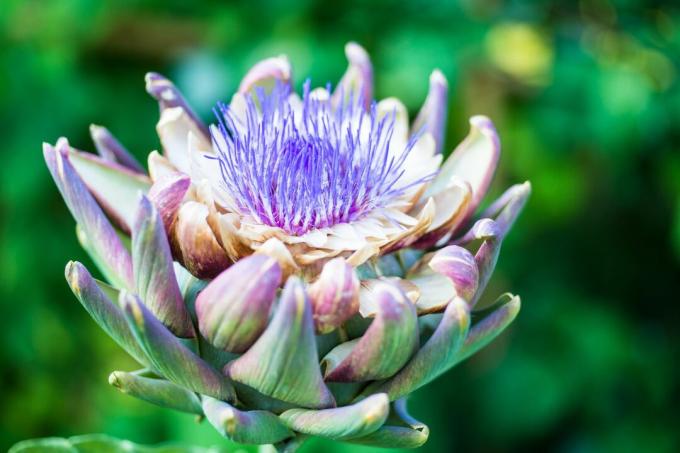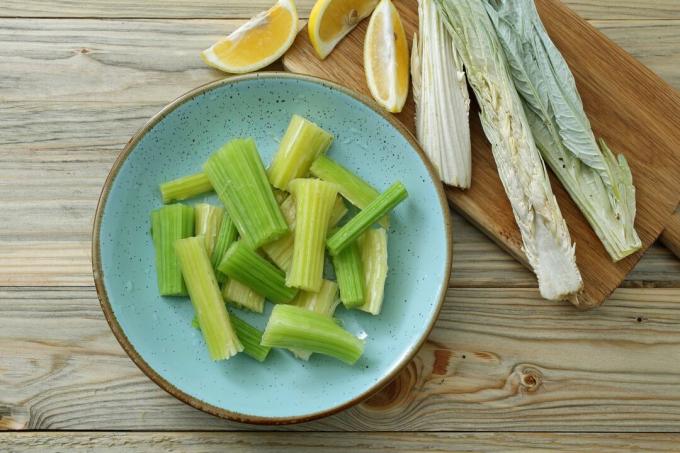The cardoon (also called cardy) is an old and particularly tasty type of vegetable that also thrives in our climate. Cardoons bloom particularly conspicuously.

Thistles are not exactly one of the favorite plants of farmers and hobby gardeners. Most of all, they are viewed as a pesky and prickly weed. However, the thistle-like plants also include the artichoke, which is so valued in Mediterranean cuisine, and also the cardy. The Cardy (Cynara cardunculus var. altilis), also called cardoon or vegetable artichoke, is one of the daisy family, including the artichoke (Cynara cardunculus var. scolymus) heard.
contents
- Cardy or artichoke: the little things make the difference
- The robust cardoon: an insider tip for the hobby gardener
- Varieties: can it be prickly?
- Early autumn: collect the harvest
- The taste of the ancient Egyptian delicacy
The prickly cardy originally comes from the Mediterranean region and is still mainly grown in that area today. Egypt, Algeria, Tunisia, Greece, Italy, France and Spain are among the main cultivation areas. During archaeological excavations, drawings of cardy and artichokes were discovered in the tombs of the pharaohs. Thus, the Cardy should be one of the oldest cultivated plants of mankind.
You can find out more about their origins in our article Cardy: origin, origin and synonyms.
Cardy or artichoke: the little things make the difference
Since both types of vegetable are genetically closely related, you have to look carefully to see any differences. Both varieties can reach heights of up to two meters and are usually prickly. Special thornless breeds are an exception. While the budding inflorescences of artichokes can be eaten, the thickened leaf stalks of the cardy land on the plate.

The robust cardoon: an insider tip for the hobby gardener
Cardy is grown as a vegetable as an annual. Many garden lovers also prefer another perennial plant for ornament. At the beginning of May, 3 to 4 seeds are planted directly in the open ground at a distance of 6 centimeters. Four weeks after budding, only the most vigorous plants are left to stand. The seeds of the cardoon can also be brought forward from the end of March and put outside from the end of May. Deep, nutrient-rich and slightly moist soils are ideal. A space requirement of one square meter can be expected per plant.
You can find detailed step-by-step instructions here: Growing Cardy & Kardone: sowing, care and harvest time.
Varieties: can it be prickly?
It is true that there are now stingless ones Cardoon varietiesHowever, among cardy connoisseurs, the varieties with thorns are still preferred because of their aroma. In the end, every garden lover has to decide for himself whether this justifies the additional work involved in cultivating and harvesting.
- Cardon argente épineux de Plainpalais
- Argenté de Genève
- Centofogly
- Gobbo gigante di Romagna
Early autumn: collect the harvest
From September the tasty stalks of the cardoon can be harvested, which are up to 80 cm long. Gourmets bleach the stems a few weeks before harvest to reduce the amount of bitter substances they contain. For this purpose, the plant is tied up and wrapped in black foil or cardboard. This process is quite complex, which is why the plants in agricultural cultivation are now often bleached in a dark storage room after harvest.

Even in hobby cultivation, the cardoon can no longer be bleached outdoors from mid-October to the end of October. This can be remedied: The plant, including the earth ball, must be bleached in a cool and dark cellar. The stems of the cardoon can be kept for four to six weeks under good storage conditions.
The taste of the ancient Egyptian delicacy
Unfortunately, these wonderful winter vegetables can hardly be found on the local markets. Cardy tastes slightly bitter, artichoke-like with a nuance of nut flavors. Friends of artichoke, rocket, radicchio and chicory will love the excellent taste of cardoon. First you clean the stems thoroughly and then - similar to rhubarb - the fibrous skin is generously peeled off. The cardy stems, cut into 4 to 8 centimeters, are best prepared in the pan or in the oven.

We have delicious recipes for you for these wonderful winter vegetables. Give it a try in the coming gardening season: your neighbors and your palate will be surprised.
Like you the close related Planting and caring for the artichoke, learn from this article.
Many thanks to the hardworking photographers: Edsel Little, Leonora (Ellie) Enking, peganum, FOTOGRAFÍAS CANAL SUR, Txaber Allue Marti and Andreu Serra.
